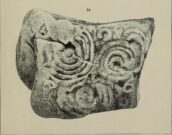Healing Well (destroyed): OS Grid Reference – SE 45 21
Archaeology & History
The waters of the once-renowned Organn Well goes down in history as being one of the first wells in Britain whose waters were used in a town pump. Written minutes from an early council meeting described how people gathered in the market place to discuss the objective of making such a pump in the times of Queen Elizabeth 1, in 1571. It was completed a year later and, some 450 years on, this old relic can still be seen. The Well used to be found off Penny Lane (now Wakefield Road), some 4-500 yards to the southwest and as such it’s exact position has been difficult to locate. But the fact that the waters were piped such a distance strongly suggests that the water supply from the Well was damn good – and most probably damn refreshing too! The old charter told us, in that wonderfully dyslexic manner of the period,
“…that a conduit in the Markett Place with lead pipes leading to water from Organ Well to the said conduit shall bee cleansed and repayred at the charge and contribution of severall inhabitants of the Towne and espetially by those that fetch water from the same conduit. And according to the auncient custome of the said Towne, whoe shall not beare theire p’t of the chardge p’portionable to what water they from the same at the discretion of the Majo’ for the time being and his brethren shall be debarred from the benefitt of the said conduit except they shall be poore people. And likewise that none shall receive any water from the said conduite for to brewe or steep barley w’thall at such time or times as others have need the same for meat water and water to washe w’hall, but onely at such times as there is water to spare over and besides what is convenient for meat and washing.”
More than two hundred years later the water pump was in dire need of attention, as George Fox (1827) told:
“Being in a ruinous state about the year 1810 and the supplies of water being insufficient for the public use; a clause was inserted in the act of parliament… wherein the pump, its pipes, and all other appurtenances belonging to it were vested in the power of the commissioners of the streets, who where bound to see it kept in proper repair.”
And so the water from the Organn Well continued to supply the townsfolk.
The etymology of this well—along with another of the same name near Harrogate—truly puzzled me for a long time; that was until I came across, quite by accident, records from early texts on herbalism. As a result, it seems very likely that it derives its name from the old English ‘organe,’ which, according to Stracke (1974) and others relates to both varieties of the indigenous herb marjoram (Origanum vulgare and O.marjorana) — a grand medicinal plant that’s pretty common in northern England (I used to go out gathering it each year in my younger days). There were obviously profuse supplies of this herb growing in and around the well and, as all good herbalists will tell you, when they grow by an old spring or well, their medicinal properties are much better than normal. The waters and the plant obviously had a good symbiosis; or, as the old women who’d collect the waters and the herbs in days prior to the pump would have told us, “the spirits of the water here are good”…
References:
-
- Fox, George, The History of Pontefract in Yorkshire, J.Fox: Pontefract 1827.
- Padgett, Lorenzo, Chronicles of Old Pontefract, Oswald Homes: Pontefract 1905.
- Stracke, J. Richard (ed.), The Laud Herbal Glossary, Rodopi: Amsterdam 1974.
© Paul Bennett, The Northern Antiquarian





